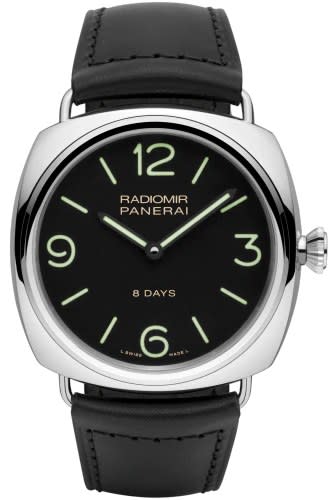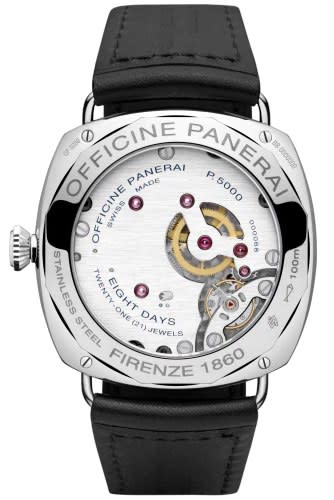The Long, Formerly Radioactive History of the Panerai Radiomir
Maybe the best way to explain the watchmaker Panerai’s appeal is by reference to the kinds of wrists its watches usually land on. Forget James Bond—Panerai makes beefy, brawny watches worn by the beefier, brawnier likes of Sylvester Stallone and Arnold Schwarzenegger. And unlike other manufacturers, which evolved to eventually focus on hard-wearing timepieces, Panerai was from the beginning defined by deep-diving tool watch production, and the kind of out-there technological breakthroughs that industry requires. Right out of the gate, the brand's Radiomir introduced new standards while literally glowing like a radioactive beacon, its long, thorny history shedding light on some of the gnarlier corners of the 20th century. If all of menswear history can be traced back to military uniforms, a certain portion of the watch world has a similar connection to Panerai's WWII-era inventions.
Giovanni Panerai first opened the doors of Officine Panerai on Florence’s Ponte alle Grazie in 1860; evenutally, the business was taken over at the turn of the century by Guido Panerai, Giovanni’s grandson. The world was changing radically. With ugly wars on the horizon, and the industrial revolution in full swing, Panerai shifted its efforts towards the production of precision instruments, including depth gauges and compasses.
Diver’s instruments were by no means a Panerai invention, but the luminous material found on their dials was. Patented in France in 1916, the brand’s proprietary compound was called “Radiomir,” thanks to the fine, radium-based-powder that afforded its luminous properties. Though highly radioactive (with exposure now known to result in anemia, bone fractures, and necrosis), the powdered substance was particularly useful for Panerai’s products, which needed to function in the gloomy depths of the ocean. The Royal Italian Navy, not one to turn down a chance to literally see in the dark, in turn commissioned Panerai to produce a similarly luminous timepiece for underwater use.



Covertly manufactured under top-secret classification, this timepiece was named for that special compound—the Radiomir. With tensions rising, and the second World War fast approaching, the 47 mm Radiomir was introduced to Royal Italian Navy divers in 1936. Known as the Ref. 3646, these luminous watches featured cushion-shaped cases crafted out of stainless steel, which were secured to heavy duty leather straps using a set of welded wire lugs. (These watches were powered by hand-wound movements supplied and signed by Rolex—considered the best under demanding conditions.)
As the war progressed, so too did the Radiomir. The reference’s dials became more legible and luminous as Panerai experimented with new manufacturing techniques, and the case received an entire redesign at the request of the Navy. Starting in 1940, Radiomirs were manufactured out of a single block of steel. Following the war, the Radiomir would then be upsized to an astounding 60 mm for the Egyptian Navy, and fitted with a unique crown guard similar to that of the brand’s Luminor models.
Throughout these several decades of production, all of Panerai’s watches and supply contracts were classified secrets, which were further classified after the war had ended—meaning the now-wildly popular line of timepieces was unavailable and unknown to the masses. With the war over, the brand returned to the dedicated production of diving instruments. For 21 years, that remained the case—until 1993, when the brand shifted toward producing timepieces for civilian use.
Today, Panerai’s history influences the aesthetics of its current lineup, which includes several Radiomir models, though under the ownership of Richemont, the watchmaker is a different animal altogether. Its grassroots, military-contracted past has been traded for a present informed by the luxury market: the watches now use smaller, in-house movements. While the worn-by-the-Navy 47mm watches are no longer produced using radium, their defining style has been maintained and celebrated through pieces like the true to form “PAM448” Radiomir, and the more recent Radiomir 1940. And while the Italian Navy was devastated by the war, its commissioned watch has had a long, glowing-in-the-dark afterlife.
Originally Appeared on GQ
